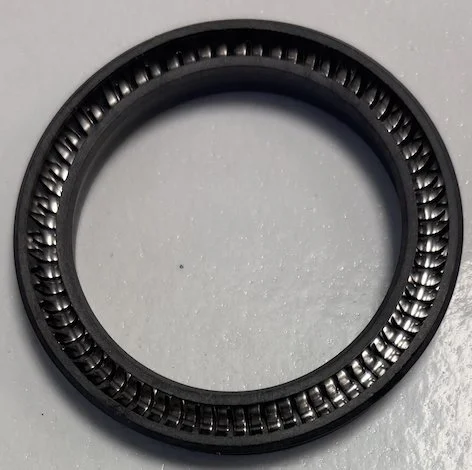
Interface Connect (IC®) builds a strong, durable interphase between polymer (PTFE) and engineered fillers. Below are our two core IC®-Mica/PTFE and IC®-Graphite/PTFE, with typical characteristics, advantages, and where they shine.
IC®-mica/PTFE composite
IC-Mica/PTFE is your go-to when dimensional control, stiffness, and wear resistance matter most. IC strengthens the polymer–filler interphase so mica truly reinforces PTFE rather than just “sitting” in the matrix.
Key advantages:
Higher stiffness and reduced creep
Lower wear rate and broad chemical resistance of PTFE
Lower shrinkage for tight tolerances
Properties (standard):
Density: 2.11 g/cm³
Hardness (Shore D): 67
Shrinkage: 0.4%
Tensile modulus (ASTM D638): 428 ksi (≈ 2.95 GPa)
Wear rate (JIS K 7218): 1.336 × 10⁻⁷ mm³/(N·m)
Typical applications :
Valve seats and stem/rod seals requiring dimension hold across temperature/pressure; Gaskets and pump components for chemical service; Guide rings/wear elements where stability > maximum lubricity; Precision parts in instrumentation/analytical where drift must be minimized
IC®-graphite/PTFE composite
IC-Graphite/PTFE prioritizes low friction. With IC, the interface carries load and moves heat more effectively, supporting longer life in dry or marginally lubricated service.
Key advantages:
Low coefficient of friction; excellent dry/wet sliding behavior
Effective heat dissipation via graphite network
Broad chemical compatibility
Properties (standard):
Density: 2.07 g/cm³
Hardness (Shore D): 63
Shrinkage: 1.08%
Tensile modulus (ASTM D638): 329 ksi (≈ 2.26 GPa)
Wear rate (JIS K 7218): 4.895 × 10⁻⁷ mm³/(N·m)
Typical applications :
Valve seats and stem/rod seals requiring dimension hold across temperature/pressure; Gaskets and pump components for chemical service; Guide rings/wear elements where stability > maximum lubricity; Precision parts in instrumentation/analytical where drift must be minimized




